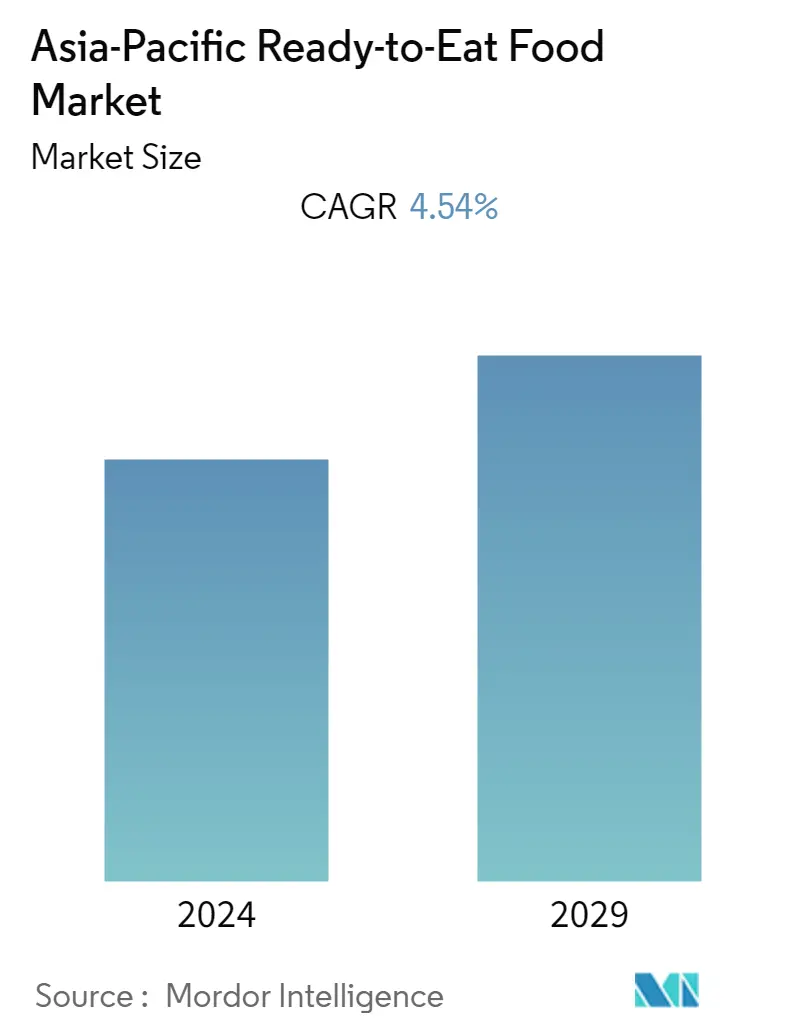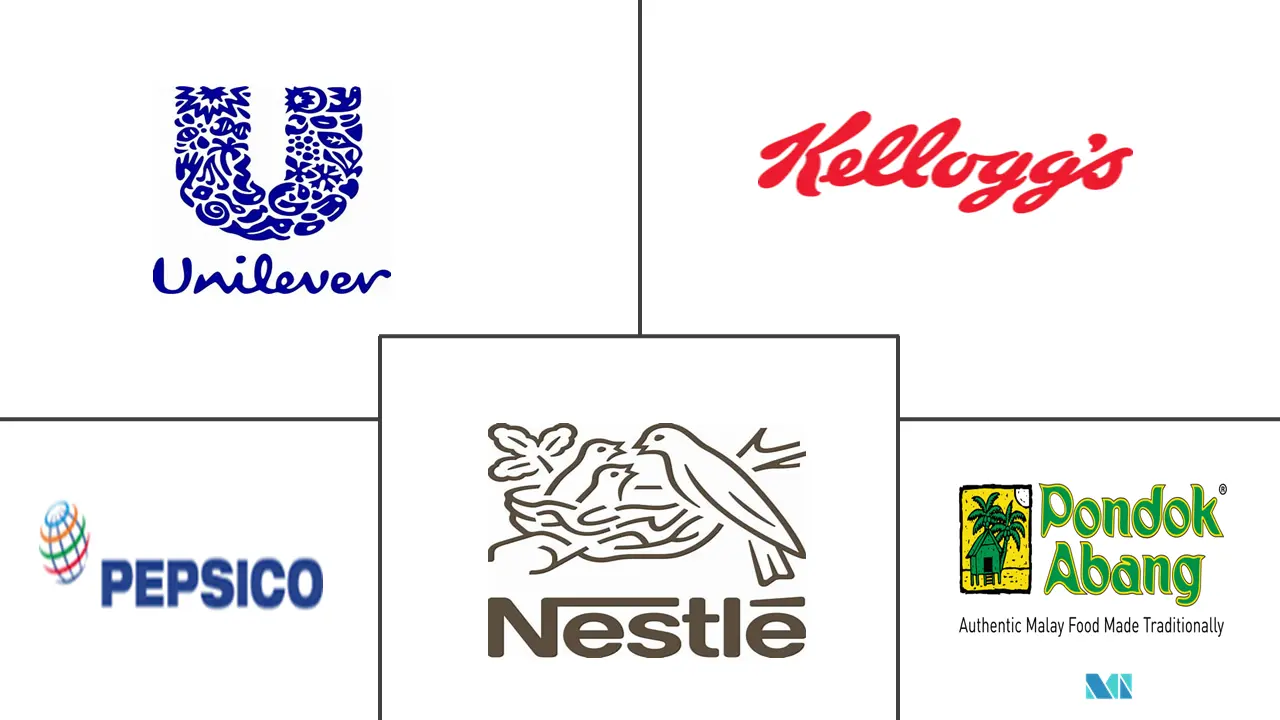Market Size of Asia-Pacific Ready-to-Eat Food Industry

| Study Period | 2019 - 2029 |
| Base Year For Estimation | 2023 |
| Forecast Data Period | 2024 - 2029 |
| Historical Data Period | 2019 - 2022 |
| CAGR | 4.54 % |
| Market Concentration | Low |
Major Players
*Disclaimer: Major Players sorted in no particular order |
APAC Ready to Eat Food Market Analysis
The Asia-Pacific ready-to-eat food market was valued at USD 126.87 billion for the current year and is projected to register a CAGR of 4.54% over the next five years.
- The ready-to-eat-food market is experiencing significant growth. As a result of the new hybrid working patterns and hectic consumer lifestyles point to a larger number of frozen ready meals being consumed in the foreseeable future. Due to fast-paced lifestyles, the need for a quick meal or snack among adults has been driving the demand for healthy and convenient food that can be consumed instantly. Frozen food products are considered beneficial as they can be cooked within less time for consumption. These factors have been propelling the market growth. The ready-to-eat-food market is driven by the increasing demand for convenience and healthy food options.
- Additionally, the trend towards more plant-based/vegan ingredients and the use of sustainable packaging with less plastic and waste is continuing to change the way packaged food boxes are perceived overall. Therefore, brands are under more pressure to provide better products for the environment. For instance, in May 2022, Plix announced its plans to expand its product portfolio by launching its plant-based snackable functional foods in India. The company claims that the Plix'ssnackable useful food range includes High Protein Peanut Butter With 25G Plant Protein & Superfoods, Lean Fudge Bar Chocolate 5G Protein, Brain Fudge Bar Mocha Fudge 5G Protein, and Skin Fudge Bar Berry Blast with 5G Protein. All of its products claim to be plant-based, chemical and preservative-free products. Therefore, sustainable Ready-to-Eat Food products further drive the market in this region.
APAC Ready to Eat Food Industry Segmentation
Ready-to-eat foods are made for direct consumption and do not require much further processing. They are mostly consumed without prior preparation or cooking.
The Asia-Pacific ready-to-eat food market is segmented by product type, distribution channel, and country. By product type, the market is segmented by instant breakfast/cereals, instant soups and snacks, ready meals, baked goods, meat products, and other product types. Based on distribution channels, the market is segmented by supermarkets/hypermarkets, convenience/grocery stores, specialty stores, online retail stores, and other distribution channels. By geography, the market is segmented by China, Japan, India, Australia, and the rest of the Asia-Pacific.
The market sizing has been done in value terms in USD for all the abovementioned segments.
| Product Type | |
| Instant Breakfast/Cereals | |
| Instant Soups and Snacks | |
| Ready Meals | |
| Baked Goods | |
| Meat Products | |
| Other Product Types |
| Distribution Channel | |
| Supermarkets/Hypermarkets | |
| Convenience/Grocery Stores | |
| Speciality Stores | |
| Online Retail Stores | |
| Other Distribution Channels |
| Country | |
| China | |
| Japan | |
| Australia | |
| India | |
| Rest of Asia-Pacific |
Asia-Pacific Ready-to-Eat Food Market Size Summary
The Asia-Pacific ready-to-eat food market is experiencing robust growth, driven by the increasing demand for convenience and healthy food options. The shift towards hybrid working patterns and fast-paced lifestyles has led to a rise in the consumption of frozen ready meals, as they offer quick and easy meal solutions. This trend is further supported by the growing preference for plant-based and vegan ingredients, alongside sustainable packaging solutions that reduce plastic waste. Companies are responding to these consumer demands by expanding their product offerings to include healthier and environmentally friendly options. The market is also benefiting from the rise of quick commerce, which facilitates the rapid delivery of ready meals, allowing consumers to explore diverse cuisines and flavors from the comfort of their homes.
The competitive landscape of the Asia-Pacific ready-to-eat food market is characterized by the presence of both domestic and multinational players, all vying for a larger market share. Key companies are focusing on strategic initiatives such as mergers, acquisitions, and new product development to enhance their market presence. The introduction of innovative products, including those with naturally derived ingredients, is a common strategy to meet the evolving consumer preferences. Despite the growing demand for convenient food options, there is a notable shift towards healthier snack alternatives due to rising lifestyle-related health concerns. This dynamic market environment is prompting continuous product innovation to cater to the diverse needs of consumers across the region.
Asia-Pacific Ready-to-Eat Food Market Size - Table of Contents
-
1. MARKET DYNAMICS
-
1.1 Market Drivers
-
1.1.1 Rising Demand For Ready Meals Food Products to Influence Growth
-
1.1.2 Increasing Demand for Organic and Vegan Ready-to-Eat food products.
-
-
1.2 Market Restraints
-
1.2.1 Rising Concern Over Health Issues Associated with Processed Foods
-
-
1.3 Porter's Five Forces Analysis
-
1.3.1 Threat of New Entrants
-
1.3.2 Bargaining Power of Buyers/Consumers
-
1.3.3 Bargaining Power of Suppliers
-
1.3.4 Threat of Substitute Products
-
1.3.5 Intensity of Competitive Rivalry
-
-
-
2. MARKET SEGMENTATION
-
2.1 Product Type
-
2.1.1 Instant Breakfast/Cereals
-
2.1.2 Instant Soups and Snacks
-
2.1.3 Ready Meals
-
2.1.4 Baked Goods
-
2.1.5 Meat Products
-
2.1.6 Other Product Types
-
-
2.2 Distribution Channel
-
2.2.1 Supermarkets/Hypermarkets
-
2.2.2 Convenience/Grocery Stores
-
2.2.3 Speciality Stores
-
2.2.4 Online Retail Stores
-
2.2.5 Other Distribution Channels
-
-
2.3 Country
-
2.3.1 China
-
2.3.2 Japan
-
2.3.3 Australia
-
2.3.4 India
-
2.3.5 Rest of Asia-Pacific
-
-
Asia-Pacific Ready-to-Eat Food Market Size FAQs
What is the current Asia-Pacific Ready-to-Eat Food Market size?
The Asia-Pacific Ready-to-Eat Food Market is projected to register a CAGR of 4.54% during the forecast period (2024-2029)
Who are the key players in Asia-Pacific Ready-to-Eat Food Market?
PepsiCo Inc., Pondok Abang, Nestlé S.A., Unilever PLC and The Kellogg's Company are the major companies operating in the Asia-Pacific Ready-to-Eat Food Market.

